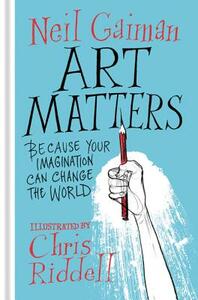You need to sign in or sign up before continuing.
Take a photo of a barcode or cover
A lovely little book. Made even more delightful on Audiobook.
hopeful
inspiring
lighthearted
reflective
fast-paced
inspiring
hopeful
inspiring
reflective
medium-paced
I really wanted a print copy of Make Good Art, but I didn't care for the edition designed by Chip Kidd (heresy, I know). So I'm pleased as punch with this cute little illustrated edition with Chris Riddell, which also includes a few other pieces, including one about the importance of libraries!
This is a book which can be devoured in one sitting. I love the way in which Gaiman presents his thoughts and the perfection of drawings created by Chris’s Liddell.
The book is divided into four equal parts (credo, why our future depends on libraries, reading and daydreaming, making a chair, and make good art.) I feel that each section can be read altogether or are strong enough to be independently read.
“Credo” presents the concept that all ideas are free and constantly being spread. I felt this section of the book is most powerful because you can have an idea and that this idea can change the world. Ideas are always being created and can not be vanquished by killing or hurting anyone with the idea. We don’t have to share the same ideas or agree on the same idea but we should respect each other’s ability to have ideas.
In “why our future depends on libraries, reading and daydreaming,” Gaiman expresses his love of libraries and of the written word. He strongly suggests reading fiction and says that reading fiction helps build empathy. I also like that he holds the library is high esteem since this was the first place where he was treated with respect as an eight year old boy. He also advocates for reading for pleasure and allowing children to read whatever they want since this will assist in creating and maintaining a lifelong love of reading.
The third section entitled “making a chair,” the author laments that he was planning to write but instead decided to assemble a chair. The task of putting a chair together is much more involved that he initially thought. Eventually, he compares the process of assembling a chair to that of assembling a book and recommends that maybe books should come with warning labels.
The final section of the book is “make good art” focuses on Gaiman’s work journey. Gaiman doesn’t call his writing journey a career because to him, careers are planned out versus him completing a lost of things he wanted to do at age 15. The purpose of of a career, (according to Gaiman) is to have no idea what you’re doing and this way, you don’t know if you’re breaking rules. He also recommends embracing failure and be more focused on the work you’re doing rather than the payoff for doing it.
He ends the book by saying to create art that is uniquely you and reflective of your life experiences. Also it is vital to use art as a coping mechanism for when this are good, bad, or indifferent. This was an enjoyable speed read and I’m glad I took the time to pick it up and get inspired to create new ideas.
The book is divided into four equal parts (credo, why our future depends on libraries, reading and daydreaming, making a chair, and make good art.) I feel that each section can be read altogether or are strong enough to be independently read.
“Credo” presents the concept that all ideas are free and constantly being spread. I felt this section of the book is most powerful because you can have an idea and that this idea can change the world. Ideas are always being created and can not be vanquished by killing or hurting anyone with the idea. We don’t have to share the same ideas or agree on the same idea but we should respect each other’s ability to have ideas.
In “why our future depends on libraries, reading and daydreaming,” Gaiman expresses his love of libraries and of the written word. He strongly suggests reading fiction and says that reading fiction helps build empathy. I also like that he holds the library is high esteem since this was the first place where he was treated with respect as an eight year old boy. He also advocates for reading for pleasure and allowing children to read whatever they want since this will assist in creating and maintaining a lifelong love of reading.
The third section entitled “making a chair,” the author laments that he was planning to write but instead decided to assemble a chair. The task of putting a chair together is much more involved that he initially thought. Eventually, he compares the process of assembling a chair to that of assembling a book and recommends that maybe books should come with warning labels.
The final section of the book is “make good art” focuses on Gaiman’s work journey. Gaiman doesn’t call his writing journey a career because to him, careers are planned out versus him completing a lost of things he wanted to do at age 15. The purpose of of a career, (according to Gaiman) is to have no idea what you’re doing and this way, you don’t know if you’re breaking rules. He also recommends embracing failure and be more focused on the work you’re doing rather than the payoff for doing it.
He ends the book by saying to create art that is uniquely you and reflective of your life experiences. Also it is vital to use art as a coping mechanism for when this are good, bad, or indifferent. This was an enjoyable speed read and I’m glad I took the time to pick it up and get inspired to create new ideas.
Concise, witty, and intelligent commentary on the creative mind. Excellent illustrations by Chris Riddell, as per usual.
It's a very quick read but one that requires re-reading. I found myself nodding my head a lot as I flipped through the pages.
Excellent excellent audiobook. Stuck in a rut? Listen to this book. Need an ego boost? Need motivation? Need inspiration? Read this book. Great nuggets of wisdom and quotable quotes.





